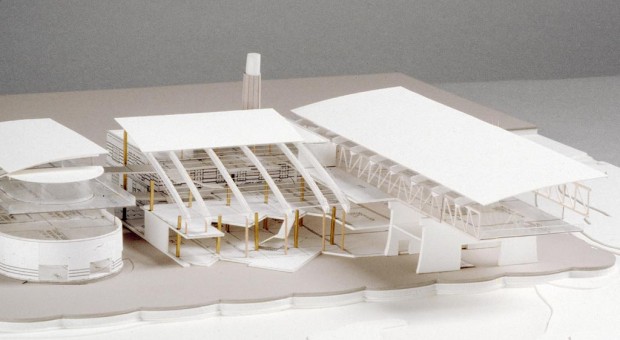- Waste Water Facility Adaptive Reuse
Waste Water Facility Adaptive Reuse

Boulevard Sewage Treatment Plant
New Haven, Connecticut
In 1988 New Haven, Connecticut initiated a Public Art Competition for a site at Long Wharf Park. Michael Singer won the competition with a proposal to use the Public Art funding meant for a sculpture at Long Wharf Park as a way to finance an urban plan for the entire site. The site is located adjacent to Interstate 95, encompasses the historic Long Wharf to the north, one mile of harbor front and the defunct Boulevard Sewage Treatment Plant to the south. Singer led a team consisting of an environmental engineer, historian, social anthropologist, biologist, interpretive planner and architect. The master plan recommended mitigation strategies for the cleanup of the polluted harbor front, as well as educational, recreational and cultural programs.
The 1992 master plan also investigated a number of possibilities for reusing the defunct Boulevard Sewage Treatment Plant at the south end of the park including reusing the building as a vocational training facility for aquaculture. The master plan described an opportunity for the large storage tanks on site to be refurbished and reused to grow brackish-water fish and wetland plants for salt marsh restoration projects. In 1995 Singer was commissioned by the New Haven Department of Parks and Recreation and the New Haven Department of Education to work with Architect Paul Pizzo to develop the plan and conceptual design for the reuse of the Treatment Plant. The conceptual design proposed retaining most of the original 1939 art deco brick building and building a series of glass and steel structures above and around the historic base. During this time Singer was introduced to The Sound School, an inter-district college preparatory high school that concentrates in the study of aquaculture and marine trades. The Sound School’s existing programs were based just down the street from the Treatment Plant but they were considering relocating to Black Rock Harbor in Bridgeport, Connecticut. Singer and the City helped convince the Sound School to stay in New Haven where they had been based since 1981.
The Sound School ultimately opened its new 40,000 square foot 2 story Library and Aquaculture Center in 2003, located on the foundations of the Boulevard Sewage Treatment Plant. Program spaces include fish production, genetics research, boat building, engine repair, plant biology, development of salt, fresh and brackish water aquaculture systems and a 2,000 square foot hydroponics green house. Adjacent to the Center is the 24 acre Long Wharf Nature Preserve of mud flats, dunes, salt marshes and upland habitat at the southern end of Long Wharf Park that was also an integral part of the 1992 master plan. The Preserve land was donated by the City of New Haven and remains a model precedent of urban ecological regeneration.
This project was funded in part by the National Endowment for the Arts.
Artist / Designer: Michael Singer
Singer Studio Team Project Manager: Sterling McMurrin
Architect: Paul Pizzo at Landmark Architects
City Project Team: Pam Kressman, New Haven Department of Parks,
Recreation and Trees, Joanne Reese, Project Coordinator
Photography: New Haven Land Trust, Trails of Freedom, Michael Singer

